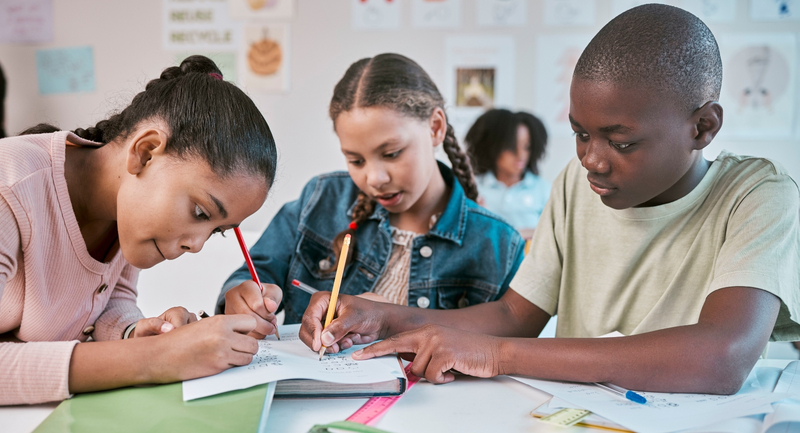One of the most important challenges we face now in America is the deep, systemic problem of racism. Since the murder of George Floyd in May, we’ve been reminded time and again that as citizens—and, specifically, as educators—we are woefully unprepared either to talk constructively about race or to truly understand one another.
As the director of the National Paideia Center, I believe genuine dialogue is the antidote to racism. The Paideia Program is designed to help schools become more rigorous and equitable. The Paideia Seminar, the signature piece of Paideia classroom instruction, is a collaborative dialogue facilitated with open-ended questions about a conceptually rich text.
Developing the skills and habits of mind necessary to talk about race in America with patience, trust, and candor is central to our goal of fostering increased understanding of others’ experience and of people’s understanding of themselves. I’ve recently been involved in creating a learning experience for educators designed to accomplish those goals.
A Way to Talk Together–Productively
This learning experience, “Dialogues on Racial Justice,” consists of four seminar experiences, each focused on one of four texts by an important Black artist or writer: How It Feels to Be Colored Me (a 1928 memoir by author and anthropologist Zora Neale Hurston); “Let America Be America Again” (a poem written in 1935 by Langston Hughes, prominent member of the Harlem Renaissance); “The Dove” (a collage produced by Romare Bearden during the Civil Rights era); and “Together, You Can Redeem the Soul of Our Nation” (contemporary statesman John Lewis’s posthumous appeal to the American people written just this year).
Educators sign up for this dialogue-based course—which can take place either virtually or face to face—either as a group or as individuals who will be placed in a cohort of 12 to 24 people. Groups can include parents, board members, and other community members, but our primary focus is educators. Before each dialogue, participants engage in multiple, close readings of the relevant text. They also take time to individually consider how they typically participate in difficult conversations.
Participants together set a group process goal (such as “to refer to the text in detail”) and individually choose personal goals in the area of engaging more deeply and thoughtfully in discussion, especially with people whose opinions conflict with theirs or who come from a different background or race. For example, a personal goal might be “to build off others’ comments.”
Each dialogue is structured by the seminar’s facilitator, who also ask spontaneous questions during the discussion, based on participant responses. Questions are designed to be open-ended, thought-provoking, and clear. For example, a core question for the discussion around How It Feels to Be Colored Me is: “Zora writes, ‘At certain times, I have no race; I am me.’ What do you think she means?” As the sequence of seminars unfolds, participants suggest issues or perspectives they’d like to address, and the facilitator may alter plans for the latter seminars to reflect these interests. Course facilitators are members of the National Paideia Center staff with training and experience in seminar facilitation.
After each seminar, participants reflect together on their success in relation to both process goals. This debrief sets the stage for how they might dialogue more effectively and respectfully in the next seminar.
Delving into the Realities of Racism
In a Paideia seminar, “dialogue”means the free and open exchange of ideas–leading not necessarily to agreement, but rather to a deeper, more sophisticated understanding. That increased understanding unfolds in relation to the text under discussion, the ideas and values represented there, and the participants in the dialogue.
In good faith, educators in our course delve into the Black experience and the realities of racism through examining these texts and dialoguing. The course works best if there’s a mix of different races in the group, so Black and brown participants can share with white educators about their experiences. Seminars work most powerfully when driven by a variety of experiences and perspectives. That said, a group composed predominantly of white educators can also lead to new understandings (especially if the facilitator adjusts the questions accordingly). For example, the facilitator might ask a predominantly white group the question, “Based on the text, what message do you think Langston Hughes has for white educators in 2020?”
After each dialogue, in addition to reflecting on how they met their group and personal goals, participants individually create a written or visual statement modeled after the text under consideration. For example, after reading and discussing How It Feels to Be Colored Me, each participant writes a short essay with a similar title, exploring their own racial identities in relation to others in the group and society at large.
Imagine…
Imagine how valuable it would be if dialogues like these resulted in an increased understanding of the Black experience and the racism in our schools, an increased respect for the others (of whatever race or background) in the seminar circle, and an increased understanding of oneself. Educators across the country must develop skills and habits of mind that will enable them to talk about race in America with almost anyone, anywhere–and to engage in powerful conversations about race with colleagues and students. Although this course isn’t designed to counter all the toxic effects of systemic racism in schools–which will take many different kinds of actions and efforts long-term–it is designed to make educators more aware and enable us to collaborate in efforts for racial justice.
By talking about race with candor and empathy, we might learn to respect each other’s experiences in ways that counter the toxic effects of systemic racism. If schools became hotspots of dialogue and understanding, it might make it more likely that the next generation will grow up armed with the ability to fight racial injustice, with open minds and open hearts. This is asking a lot of what some would label “mere conversation.” But through conversation comes understanding, and through understanding comes action. From long experience, I know that dialogue has the power to unite and heal us. I believe we can learn to talk about race, and, in reasoning together, redeem ourselves.
Note: Participation in this course is available, for a fee, through the National Paideia Center (contact info@paideia.org). ASCD has no affiliation with the center or the course.
About the author
Terry Roberts (troberts@paideia.org) is founder and director of the National Paideia Center.
Terry Roberts and Laura Billings are the director and associate director of the National Paideia Center (NPC), which provides transformative professional development across the United States and abroad. The NPC is widely celebrated as a primary source for materials and training on classroom dialogue at all levels and in all subjects. Roberts and Billings have written extensively about the relationship between seminar discussion and critical thinking, most recently in their book Teaching Critical Thinking: Using Seminars for 21st Century Literacy. They can be reached through the NPC website or via e-mail at troberts@paideia.org and laura@paideia.org.








